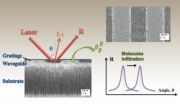(Press-News.org) FORT LEE, N.J., May 26, 2011 -- Neurologix, Inc. (OTCBB: NRGX) announced the presentation today of efficacy results through one year of follow-up in patients treated as part of the Company's successful Phase 2 clinical trial for its novel, investigational gene therapy NLX-P101 for the treatment of Parkinson's disease (PD). Improvements in the Unified Parkinson's Disease Rating Scale (UPDRS) at 12 months for the randomized, double-blind, sham surgery-controlled trial of 45 subjects with advanced PD confirmed that patients treated with NLX-P101 experienced sustained, positive, long-term benefits. The one-year follow-up data were presented by one of the scientific co-founders of Neurologix, Michael G. Kaplitt, M.D., Ph.D., at the International Neuromodulation Society's (INS) 10th World Congress in London.
In the one-year follow-up analysis, patients treated with NLX-P101 who achieved previously defined moderate-to-large clinically-meaningful symptom improvements (≥ 9 points in off-medication UPDRS motor score), increased from 50 percent at six months to 63 percent at one year. This major subgroup of NLX-P101-treated patients experienced a mean 37 percent improvement in their symptoms after one-year, with an average improvement of 14 points in off-medication UPDRS motor score. Among all patients included in the NLX-P101 treatment group, the clinical improvements demonstrated at six months were maintained, with an average 8.2 point improvement in off-medication UPDRS motor score at 12 months compared to an 8.1 point improvement at six months. No serious adverse events (SAEs) related to the gene therapy or surgical procedure were reported in either the blinded six-month study period or the completed 12 month study phase.
"These results demonstrate that treatment with NLX-P101 improved the primary motor symptoms of Parkinson's disease in patients overall, with a majority obtaining a highly clinically meaningful improvement," said Neurologix scientific co-founder Matthew J. During, M.D., D.Sc., Professor of Molecular Virology, Immunology and Medical Genetics, Neuroscience and Neurological Surgery, The Ohio State University Medical School, and Professor of Molecular Medicine and Pathology, University of Auckland, New Zealand. "Further, the positive, durable responses we saw one-year after treatment with NLX-P101 in the Phase 2 study are consistent with the long-term efficacy demonstrated in our Phase 1 trial, the first ever to demonstrate the viability of gene therapy for the treatment of Parkinson's disease. The results from the first two phases of NLX-P101 clinical research give us great confidence in the potential of NLX-P101 as we move forward with our plans for the first Phase 3 trial for gene therapy in the treatment of this debilitating disease."
The six month results of the Company's landmark Phase 2 study were published in the peer-reviewed journal The Lancet Neurology in March of this year. Study results through six months of follow-up showed that NLX-P101 treatment led to a mean 23.1 percent improvement (8.1 points) in off-medication UPDRS motor score at the six-month study end-point, compared to a mean 12.7 percent (4.7 points) improvement with sham treatment. Improved motor control in the NLX-P101 group was seen at one month and continued virtually unchanged throughout the blinded six month study period. The improvement in UPDRS motor scores from baseline in the NLX-P101 group was significantly greater than sham subjects over the six month study period (p=0.04).
The Company's Phase 2 study findings build upon earlier positive results from the NLX-P101 Phase 1 trial, which appeared in 2007 as a cover article in The Lancet and in a second article in the Proceedings of the National Academy of Sciences. Neurologix plans to submit a Phase 3 protocol to the U.S. Food and Drug Administration (FDA) under a Special Protocol Assessment later in 2011.
"The results presented today at the INS World Congress add to a growing body of clinical evidence demonstrating that our novel gene therapy approach may provide significant clinical benefits to Parkinson's disease patients," During added. "In the treatment arm of the Phase 2 study, improved motor control was seen at one month, continued virtually unchanged throughout the six-month blinded study period and persisted through 12 months of follow-up. This suggests that the treatment effect from NLX-P101 is meaningful and durable over the long-term."
Drs. During and Kaplitt have been at the forefront of gene therapy research since 1989 and the Phase 2 trial was the culmination of nearly 20 years of progress with their work in gene transfer technology using an adeno-associated virus (AAV) vector (a disabled, non-pathogenic virus). They were the first to demonstrate that AAV could be an effective gene therapy agent in the brain, which they reported in their landmark Nature Genetics paper in 1994. Drs. During, Kaplitt and colleagues subsequently published additional research demonstrating the beneficial effects of AAV-GAD gene therapy for PD in the journal Science in 2002.
###
About the Phase 2 Study
The trial involved 45 subjects with moderate to advanced PD who were not adequately controlled with current therapies. Medical centers that participated in the study included: Henry Ford Health System; Massachusetts General Hospital; Stanford University School of Medicine; The Feinstein Institute for Medical Research of the North Shore-LIJ Health System; The Ohio State University College of Medicine; University of Colorado School of Medicine; University of Rochester School of Medicine; and Wake Forest University School of Medicine.
Study subjects were randomized to receive either NLX-P101 treatment or sham surgery. Subjects in the NLX-P101 treatment arm received infusions of the genetic material directly into bilateral subthalamic nuclei (STN), a key brain region involved in motor function. Sham-assigned subjects underwent simulation of a bilateral neurosurgical procedure. At the end of each procedure, infusion catheters were removed at the bedside and nothing was left in the brain. All procedures were performed under local anesthesia. All but one of the trial participants were discharged from the hospital within 48 hours after the surgical procedure.
The primary outcome measure was the difference in UPDRS motor scores between NLX-P101 and sham-treated subjects, when the subjects were off PD medication. Other tests assessed motor fluctuations, constancy of medication effect and neuropsychological evaluations. A clinically-meaningful response was defined based on a 25 percent mean improvement from the initial Phase 1 NLX-P101 study (9 points). Patients in the sham surgery arm of the study who continue to meet all eligibility requirements will be provided an opportunity to receive NLX-P101 in a planned cross-over study. Treated subjects continue to be evaluated in an open-label, long-term follow-up study.
A Novel Approach to Gene Therapy
NLX-P101 aims to reset the overactive brain cells in the STN to inhibit electrical activity and return brain network activity to more normal levels. In PD, the loss of dopamine-secreting neurons alters chemical signaling pathways in the brain such that input to the STN is altered. The therapeutic approach with NLX-P101 modulates the activity of the STN (which is overactive in PD) by restoring GABA, a neurotransmitter important in STN function. GABA is made by a gene called glutamic acid decarboxylase (GAD). NLX-P101 uses an AAV vector (a disabled, non-pathogenic virus) to deliver the GAD gene into the STN. Increasing GAD activity causes more GABA to be synthesized, thus helping to lessen the STN over-activity.
About Parkinson's disease
Parkinson's disease is a progressive and debilitating neurodegenerative disorder that arises from the gradual deterioration of nerve cells in the brain. It affects the control of bodily movement and is characterized by four principal features: limb tremor, limb rigidity, bradykinesia (slowness of movement) and postural instability (trouble with balance).
Parkinson's disease is typically a disease that affects people over the age of 50. According to the National Parkinson Foundation, 1 million Americans currently have PD, and an estimated 50,000 to 60,000 new cases are diagnosed each year in the United States. Standard therapy for PD often involves use of levodopa, a drug which stimulates production of dopamine. Unfortunately, many patients develop complications from this and other medications, or they can fail to be effective. An alternative treatment is electrical deep brain stimulation, which requires the implantation of permanent medical devices in the brain.
About Neurologix
Neurologix, Inc. (OTCBB:NRGX) is a clinical-stage biotechnology company dedicated to the discovery, development, and commercialization of life-altering gene transfer therapies for serious disorders of the brain and central nervous system. Neurologix's therapeutic approach is built upon the groundbreaking research of its scientific founders and advisors, whose accomplishments have formed the foundation of gene therapy for neurological illnesses. The Company's current programs address such conditions as Parkinson's disease, epilepsy, depression and Huntington's disease, all of which are large markets not adequately served by current therapeutic options. For more information, please visit the Neurologix website at http://www.neurologix.net.
Cautionary Statement Regarding Forward-Looking Statements
This news release includes certain statements of the Company that may constitute "forward-looking statements" within the meaning of Section 27A of the Securities Act of 1933, as amended, and Section 21E of the Securities Exchange Act of 1934, as amended, and which are made pursuant to the Private Securities Litigation Reform Act of 1995. These forward-looking statements and other information relating to the Company are based upon the beliefs of management and assumptions made by and information currently available to the Company. Forward-looking statements include statements concerning plans, objectives, goals, strategies, future events, or performance, as well as underlying assumptions and statements that are other than statements of historical fact. When used in this document, the words "expects," "promises," "anticipates," "estimates," "plans," "intends," "projects," "predicts," "believes," "may" or "should," and similar expressions, are intended to identify forward-looking statements. These statements reflect the current view of the Company's management with respect to future events. Many factors could cause the actual results, performance or achievements of the Company to be materially different from any future results, performance or achievements that may be expressed or implied by such forward-looking statements, including, but not limited to, the following:
The Company is still in the development stage and has not generated any revenues. From inception through March 31, 2011, it incurred net losses and negative cash flows from operating activities of approximately $60.0 million and $47.0 million, respectively. Management believes that the Company will continue to incur net losses and cash flow deficiencies from operating activities for the foreseeable future. Because it may take years to develop, test and obtain regulatory approval for a gene-based therapy product before it can be sold, the Company likely will continue to incur significant losses for the foreseeable future. Accordingly, it may never be profitable and, if it does become profitable, it may be unable to sustain profitability.
At March 31, 2011, the Company had cash and cash equivalents of approximately $5.4 million. Based on its cash flow projections, the Company will need additional financing to carry out its planned business activities and plan of operations after October 31, 2011 and to repay the promissory notes issued in 2010 as of said date. Accordingly, there is substantial doubt as to the Company's ability to continue as a going concern. The Company is currently seeking to raise funds, through public or private equity offerings, debt financings or corporate collaboration and licensing arrangements, sufficient to finance its ongoing operations. The Company does not know whether additional financing will be available when needed, or if available, will be on acceptable or favorable terms to it or its stockholders.
The Company will need to conduct future clinical trials for the treatment of Parkinson's disease using the Company's NLX technology. If the trials prove unsuccessful, future operations and the potential for profitability will be materially adversely affected and the business may not succeed.
There is no assurance as to when, or if, the Company will be able to successfully receive approval from the FDA on its Investigational New Drug Application to commence a Phase 1 clinical trial for the treatment of epilepsy.
There is no assurance as to when, or if, the Company will be able to successfully complete the required preclinical testing of its gene therapy for the treatment of depression or Huntington's disease to enable it to file an Investigational New Drug Application with the FDA for permission to begin a Phase 1 clinical trial or that, if filed, such permission will be granted.
Other factors and assumptions not identified above could also cause the actual results to differ materially from those set forth in the forward-looking statements. Additional information about factors that could cause results to differ materially from management's expectations is found in the section entitled "Risk Factors" in the Company's 2010 Annual Report on Form 10-K. Although the Company believes these assumptions are reasonable, no assurance can be given that they will prove correct. Accordingly, you should not rely upon forward-looking statements as a prediction of actual results. Further, the Company undertakes no obligation to update forward-looking statements after the date they are made or to conform the statements to actual results or changes in the Company's expectations.
Neurologix presents 1-year data from phase 2 study of NLX-P101 in Parksinson's disease
Data confirm NLX-P101 provides sustained, positive long-term efficacy
2011-05-27
ELSE PRESS RELEASES FROM THIS DATE:
Precision-tinted lenses offer real migraine relief, reveals new study
2011-05-27
EAST LANSING, Mich. — For the first time, researchers have shown why precision-tinted lenses reduce headaches for migraine sufferers, a finding that could help improve treatment options for patients battling the debilitating ailment.
Jie Huang of Michigan State University's Department of Radiology used functional magnetic resonance imaging, or fMRI, to reveal how precision-tinted lenses normalize brain activity in patients with migraine headaches, preventing such attacks.
Huang's research appears in the current edition of the journal Cephalalgia, published by SAGE.
While ...
AsiaRooms.com - Check Out Portrait of Moscow at Seoul Museum of History
2011-05-27
Portrait of Moscow has opened at the Seoul Museum of History (SMH), offering visitors a chance to learn about a broad period of Russia's past.
Images in the collection date from modern times all the way back to the late 19th century, with each one providing a snapshot of the political or social context in which it was taken.
There are 80 pictures to view, all of which have been borrowed from the Moscow City Museum (MCM).
Attendees will find the exhibition split into four sections, with one featuring historical images, another looking at scenes from Moscow's Soviet ...
Improving DNA sequencing: Sponge-like biosensor crams enormous power into tiny space
2011-05-27
WASHINGTON, May 26—Vanderbilt University engineers have created a "spongy" silicon biosensor that shows promise not only for medical diagnostics, but also for the detection of dangerous toxins and other tiny molecules in the environment. This innovation was originally designed to detect the presence of particular DNA sequences, which can be extremely helpful in identifying whether or not a person is predisposed to heart disease or certain kinds of cancer. The new sensor is described in the Optical Society's open access journal, Optics Express.
Biological chemical sensors ...
AsiaRooms.com - Singapore Open Super Series 2011 Starts in June
2011-05-27
Next month will see some of the top badminton players in the world congregate for the Singapore Open Super Series 2011.
Running from June 14th to 19th, the event is one of the highlights of the country's badminton calendar.
It takes place at the Singapore Indoor Stadium and will give attendees the chance to see the best players on the domestic scene take on international stars.
Some names to watch out for are Danny Bawa Christnanta, Vannessa Neo and Hendra Wijaya. They all came home from the recent Li Ning New Zealand International Challenge 2011 with trophies.
Christnanta ...
San Diego Daily Deals Site Sets Record
2011-05-27
San Diego's leading news site SignOnSanDiego.com recently partnered with digital agency Cuker Interactive to redesign Daily Deals, a service featuring deals of up to 90 percent off of local restaurants, attractions, and services. Located at http://dailydeal.signonsandiego.com, the program allows users to sign up to receive email notifications for daily deals, share them with friends and family, and earn credits for referral purchases. Since the site launched in March, the Daily Deals site has generated significant revenue, including a record-setting $366,035 through a single ...
Factors in berry-splitting in blueberries examined
2011-05-27
This release is available in Spanish.
U.S. Department of Agriculture (USDA) researchers and a university colleague have found several factors involved in blueberry splitting, a significant problem that can cause losses of $300 to $500 per acre.
Splitting and cracking occur in southern highbush and rabbiteye blueberries if they receive preharvest rainfall when fully ripe or approaching ripeness, according to scientists with USDA's Agricultural Research Service (ARS). ARS is USDA's principal intramural scientific research agency.
ARS horticulturist Donna Marshall, retired ...
Diabetes can be predicted 7 years before pregnancy with blood sugar and body weight
2011-05-27
OAKLAND, Calif. — A woman's risk of developing diabetes during pregnancy can be identified up to seven years before she becomes pregnant based on routinely assessed measures of blood sugar and body weight, according to a Kaiser Permanente study published in the online issue of the American Journal of Obstetrics and Gynecology.
Researchers at the Kaiser Permanente Division of Research in Oakland, Calif., studied 580 ethnically diverse women who took part in a multiphasic health checkup at Kaiser Permanente Northern California between1984 and 1996. The researchers looked ...
Songbirds tweak their tunes in different ways to cope with clamor
2011-05-27
AUDIO:
Listen to a plumbeous vireo singing in a quiet area. This was recorded by lead author Clinton Francis of the National Evolutionary Synthesis Center.
Click here for more information.
Durham, NC — Some birds that live near noisy sites can alter their songs to deal with din. But closely related species with similar songs may tweak their tunes in different ways, says a new study led by Clinton Francis of the National Evolutionary Synthesis Center in Durham, NC.
The ...
White Digital Media Announces Sasha Orman as Content Director of Food and Drink Digital
2011-05-27
White Digital Media (WDM), the leading digital business news source for C-level executives, recently announced Sasha Orman, former staff writer for Exec Digital, as the Content Director of Food and Drink Digital - one of White Digital Media's leading brands. Food and Drink Digital serves as one of WDM's nine industry sector brands, providing the latest business news to executives and professionals working in the food and beverage industry worldwide.
"I'm definitely excited to take on the responsibility of Content Director of Food and Drink Digital," explains ...
Stanford scientists turn human skin cells directly into neurons, skipping IPS stage
2011-05-27
STANFORD, Calif. — Human skin cells can be converted directly into functional neurons in a period of four to five weeks with the addition of just four proteins, according to a study by researchers at the Stanford University School of Medicine. The finding is significant because it bypasses the need to first create induced pluripotent stem cells, and may make it much easier to generate patient- or disease-specific neurons for study in a laboratory dish.
It may also circumvent a recently reported potential problem with iPS cells, in which laboratory mice rejected genetically ...
LAST 30 PRESS RELEASES:
Brain stimulation device cleared for ADHD in the US is overall safe but ineffective
Scientists discover natural ‘brake’ that could stop harmful inflammation
Tougher solid electrolyte advances long-sought lithium metal batteries
Experts provide policy roadmap to reduce dementia risk
New 3D imaging system could address limitations of MRI, CT and ultrasound
First-in-human drug trial lowers high blood fats
Decades of dredging are pushing the Dutch Western Scheldt Estuary beyond its ecological limits
A view into the innermost workings of life: First scanning electron microscope with nanomanipulator inaugurated in hesse at Goethe University
Simple method can enable early detection and prevention of chronic kidney disease
S-species-stimulated deep reconstruction of ultra-homogeneous CuS nanosheets for efficient HMF electrooxidation
Mechanical and corrosion behavior of additively manufactured NiTi shape memory alloys
New discovery rewrites the rules of antigen presentation
Researchers achieve chain-length control of fatty acid biosynthesis in yeast
Water interactions in molecular sieve catalysis: Framework evolution and reaction modulation
Shark biology breakthrough: Study tracks tiger sharks to Maui mating hub
Mysterious iron ‘bar’ discovered in famous nebula
World-first tool reduces harmful engagement with AI-generated explicit images
Learning about public consensus on climate change does little to boost people’s support for action, study shows
Sylvester Cancer Tip Sheet for January 2026
The Global Ocean Ship-Based Hydrographic Investigations Program (GO-SHIP) receives the Ocean Observing Team Award
Elva Escobar Briones selected for The Oceanography Society Mentoring Award
Why a life-threatening sedative is being prescribed more often for seniors
Findings suggest that certain medications for Type 2 diabetes reduce risk of dementia
UC Riverside scientists win 2025 Buchalter Cosmology Prize
SETI Institute opens call for nominations for the 2026 Tarter Award
Novel theranostic model shows curative potential for gastric and pancreatic tumors
How beige fat keeps blood pressure in check
Fossils reveal ‘latitudinal traps’ that increased extinction risk for marine species
Review: The opportunities and risks of AI in mental health research and care
New map reveals features of Antarctic’s ice-covered landscape
[Press-News.org] Neurologix presents 1-year data from phase 2 study of NLX-P101 in Parksinson's diseaseData confirm NLX-P101 provides sustained, positive long-term efficacy



